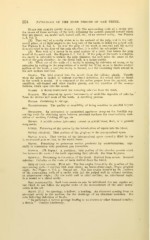Page 456 - My FlipBook
P. 456
304 PATHOLOGY OF THE HARD TISSUES OF THE TEETH.
Rules for naming cavity walls. (1) The surrounding walls of a cavity take
the names of those surfaces of the teeth adjoining the surface decayed toward which
they are placed; as, mesial wall, buccal wall, etc., of an occlusal cavity. See Figures
1, 3, Vol. 2.
(2) That wall of a cavity which is to the occlusal of the pulp, and in the hori-
zontal plane, or at right angles to the long axis of the tooth, is called the pulpal wall.
See Figures 1, 3, Vol. 2. In case the pulp of the tooth is removed and the cavity
thus extended to the floor of the pulp chamber, it is called the sub-pulpal wall.
(3) That wall of a cavity in an axial surface of a tooth that covers the pulp
is called the axial wall. See Figures 3, 7, Vol. 2. If the pulp of the tooth is removed,
the cavity is extended to include the pulp chamber, the wall takes the name of the
wall of the pulp chamber; as, the distal wall, in a mesial cavity.
(4) When one of the walls of a cavity is missing by extension of decay, or by
extension by cutting in the preparation of a cavity for filling, so as to involve another
surface of the tooth, a complex cavity is formed, and the remaining walls extend to
the new surface involved.
Saliva. The fluid poured into the mouth from the salivary glands. Usually
when the saliva is spoken of without restricted definition, the mixed fluid as found
in the mouth is meant. It is composed of the saliva proper from the parotid, sub-
maxillary, sub-lingual and other smaller glands, and the secretion of the mucous
follicles, which open into the mouth.
Scaler. A dental instrument for removing calculus from the teeth.
Scaling. The removal by special instruments of scale-like depositis of calculus
from the crowns and roots of the teeth. A curetting process.
Senile. Pertaining to old age.
Sensitiveness. The quality or capability of being sensitive to painful impres-
sion.
Separator. An instrument or mechanical appliance designed for forcibly sep-
arating teeth for obtaining space between proximal surfaces for examinations, exca-
vation of cavities, finishing fillings, etc.
Sepsin. A soluble poison (ptomain) present in putrid blood, flesh, or in proteid
compounds.
Sepsis. Poisoning of the system by the introduction of sepsin into the blood.
Septal gingivae. That portion of the gingivae in the interproximal space.
Septal space. That portion of the interproximal space normally filled by the
interproximal gum septum, or the septal tissue.
Septic. Pertaining to poisonous matter produced by microorganisms; espe-
cially in connection with persistent pus formation.
Septum. (PI. Septa.) A partition; that portion of the alveolar process which
lies between the roots of the teeth separating their alveoli. See Gum Septums.
Serumal. Pertaining to the serum of the blood. Derived from serum. Serumal
calculus: Calculus on the roots of teeth derived from the blood.
Sets op line angles. First set: The line angles formed by the junction of the
surrounding walls of cavities with each other; as, bucco-distal angle, linguo-gingival
angle. See Figure 4, Vol. 2. Second set: The line angles formed by the junction
of the surrounding walls of a cavity with (a) the pulpal wall in occlusal cavities;
as pulpo-buccal angle; (b) the axial wall in axial cavities; as, axio-buccal angle,
in a mesial or a distal cavity.
Side instruments. Such instruments as may be introduced into any regular set,
but which do not follow the regular order of the nomenclature of the other instru-
ments in the set.
Sinus. [L.] An opening; a hollow; a bending. An abnormal opening from an
abnormal cavity to the surface, for the discharge of an abnormal secretion. See
note following definition of fistula.
"In pathology, a narrow passage leading to an abscess or other diseased locality;
a fistula." Century Dictionary.


